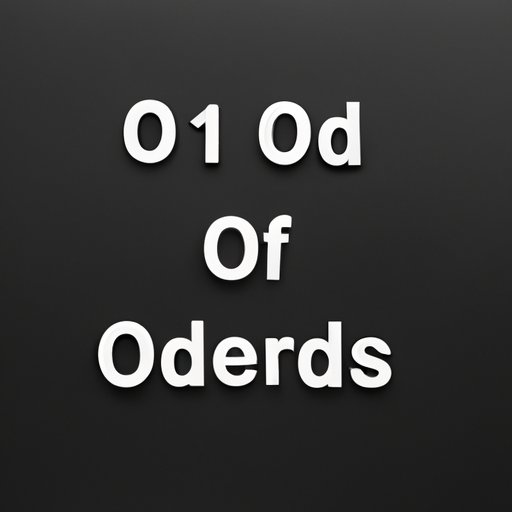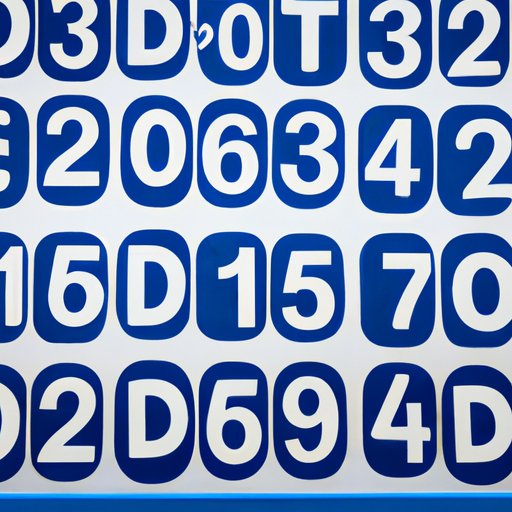Introduction
Have you ever struggled to determine which numbers are odd? You’re not alone! Understanding odd numbers can be an enigma for many people. But knowing the difference between odd and even numbers is a crucial skill in mathematics and everyday life. In this article, we’ll explore everything you need to know about odd numbers, from how to identify them to their significance in different fields.

Odd One Out: How to Determine Which Numbers Are Odd
Before we can dive into the world of odd numbers, let’s define what an odd number is. An odd number is any integer that is not divisible by two. In other words, odd numbers always have a remainder of one when divided by two. Examples of odd numbers include 1, 3, 5, 7, and 9.
Now that we know what an odd number is, let’s learn how to identify them. The easiest way to determine if a number is odd is to check if it leaves a remainder of one when divided by two. If it does, then it is an odd number. If it doesn’t, then it’s an even number.
For example, let’s consider the sequence of numbers 2, 5, 8, 9, 12. The first number, 2, is even because it’s divisible by two with no remainder. The second number, 5, is odd because it leaves a remainder of one when divided by two. The third number, 8, is even because it’s divisible by two with no remainder. The fourth number, 9, is odd because it leaves a remainder of one when divided by two. The fifth number, 12, is even because it’s divisible by two with no remainder.
To practice this skill, try identifying the odd numbers in the sequence of numbers below:
- 6, 10, 15, 20, 27, 32, 35, 46, 47
The World of Odd Numbers: A Comprehensive Guide
Now that we know how to identify odd numbers, let’s explore their world. Odd numbers have unique properties and characteristics that make them stand out from even numbers.
Odd numbers are always one less than an even number. For example, 3 is one less than 4, 5 is one less than 6, and so on. Another property of odd numbers is that when two odd numbers are added together, the resulting sum is always an even number. For example, 3 + 5 = 8, which is an even number. Lastly, odd numbers sit in the middle of even numbers; they are equidistant from the two even numbers that surround them. For example, 5 is in the middle of 4 and 6.
Odd numbers also have practical applications in different fields. In music, odd numbers create complex rhythms and time signatures. In art, odd numbers are often used to create balance and visual interest. Even in literature, odd numbers are used in literary techniques like the rule of three and the five-act structure.
Breaking Down the Mystery of Odd and Even Numbers
Odd numbers may be unique, but they also have a counterpart: even numbers. Even numbers are integers that are divisible by two without leaving a remainder. Examples of even numbers include 2, 4, 6, 8, and 10.
Odd and even numbers have different properties and characteristics. Even numbers are divisible by two, while odd numbers are not. Even numbers are always one more than an odd number. For example, 2 is one more than 1, 4 is one more than 3, and so on. When two even numbers are added together, the sum is always even. For example, 2 + 4 = 6, which is an even number.
Odd and even numbers are also related to each other. Every odd number can be expressed as the sum of two consecutive even numbers. For example, 3 can be expressed as 1 + 2, 5 can be expressed as 2 + 3, and so on. Every even number can be expressed as the sum of two consecutive odd numbers. For example, 4 can be expressed as 1 + 3, 6 can be expressed as 1 + 5, and so on.
Odd Numbers: Why They Matter in Mathematics and Beyond
Odd numbers play a significant role in mathematics. They are essential in algebra, geometry, and number theory. For example, prime numbers, which are only divisible by one and themselves, are always odd except for the number 2. Odd numbers also play a crucial role in binary and digital circuits, which are used to process information in computers.
Odd numbers also have applications beyond mathematics. One of the most significant real-life applications of odd numbers is in sports. In many sports, odd numbers are used to break ties, like in soccer penalty shootouts and tennis tie-breakers. Odd numbers are also essential in medical research, where they are used to split participants into groups for clinical trials and testing.
The Surprising History of Odd Numbers and Their Significance
The significance of odd numbers goes beyond mathematics and practical applications. Odd numbers have played a significant role in different civilizations and cultures throughout history. Ancient Egyptians believed that odd numbers were lucky and symbolic of the gods. In Chinese culture, the number eight is considered lucky because it’s made up of two even numbers, which are surrounded by odd numbers. In European culture, the number 13 is considered unlucky, and even buildings often skip the thirteenth floor.
Odd numbers have also been used in religious and spiritual practices. In Christianity, the Holy Trinity is made up of three, which is an odd number. In Hinduism, there are 33 gods, which is an odd number. In Islam, there are 99 names of God, also an odd number.
Mastering Odd Numbers: Tips and Tricks to Identify Them with Ease
While identifying odd numbers may seem straightforward, there are some common mistakes to avoid. One mistake is forgetting to check if the number leaves a remainder of one when divided by two. Another mistake is confusing odd numbers with prime numbers. Not all odd numbers are prime, and not all prime numbers are odd.
To improve accuracy and speed in identifying odd numbers, there are several helpful strategies to use. One strategy is to memorize the first few odd numbers, which include 1, 3, 5, 7, and 9. Another strategy is to use visual aids, like a number line or grid, to help identify odd numbers in a sequence. Lastly, practice makes perfect! The more you practice identifying odd numbers, the easier it will become.
When Odds Are in Your Favor: How Odd Numbers Play a Role in Probability
Probability is the likelihood or chance of an event occurring. Odd numbers play a role in probability because they can affect the outcome of certain events. For example, when rolling a die, there are three odd numbers and three even numbers. The probability of rolling an odd number is 3/6, or 1/2. When flipping a coin, there are two possible outcomes: heads or tails. If you flip a coin three times, the probability of getting odd numbers is 4/8, or 1/2.
Conclusion
Odd numbers are more than just numbers that can’t be evenly divided by two. They are unique, fascinating, and have practical applications in different fields. Understanding odd numbers is a crucial skill that can improve your math abilities, problem-solving skills, and even your luck. So next time you come across a sequence of numbers, don’t forget to look for the odd ones out!
Remember to use common strategies, like memorization and visual aids, to help identify them with ease. With practice and persistence, identifying odd numbers will become second nature, and you can impress your friends and family with your newfound odd knowledge.
